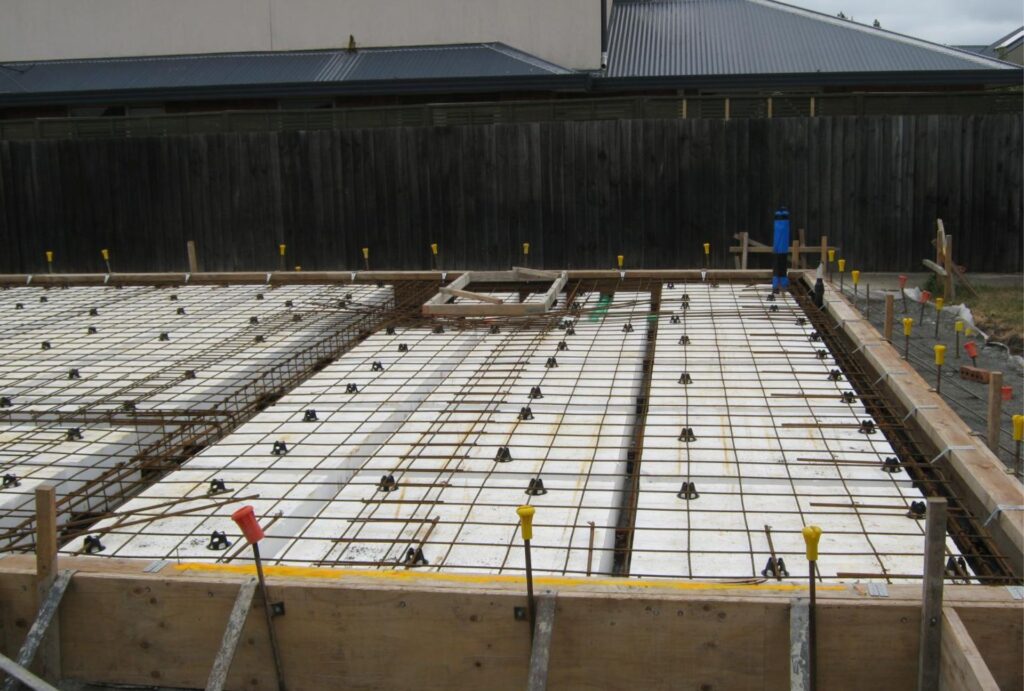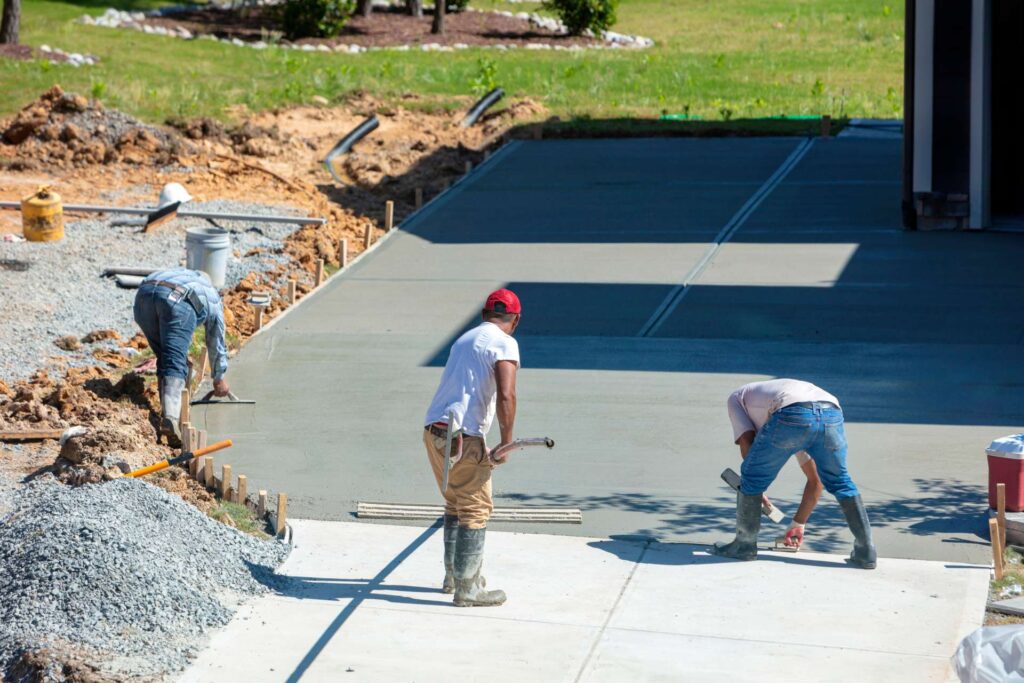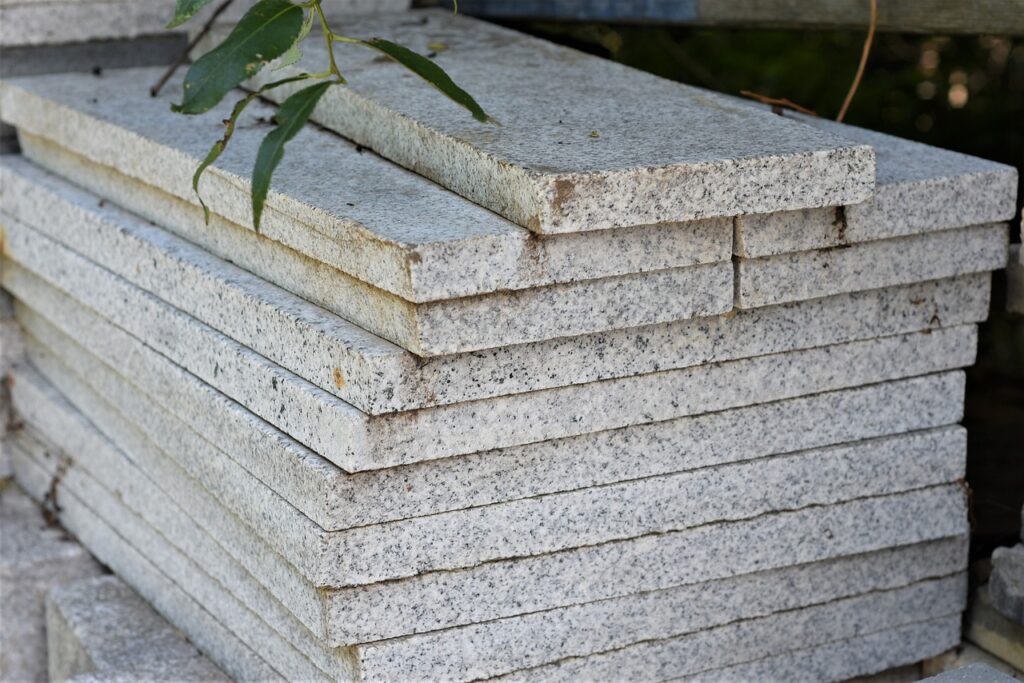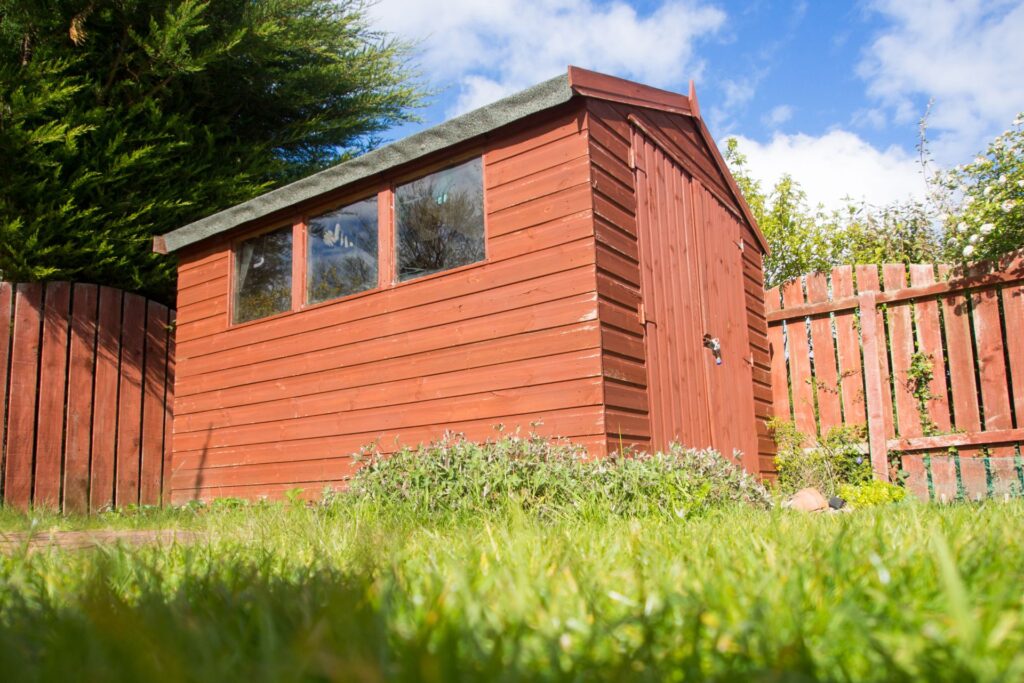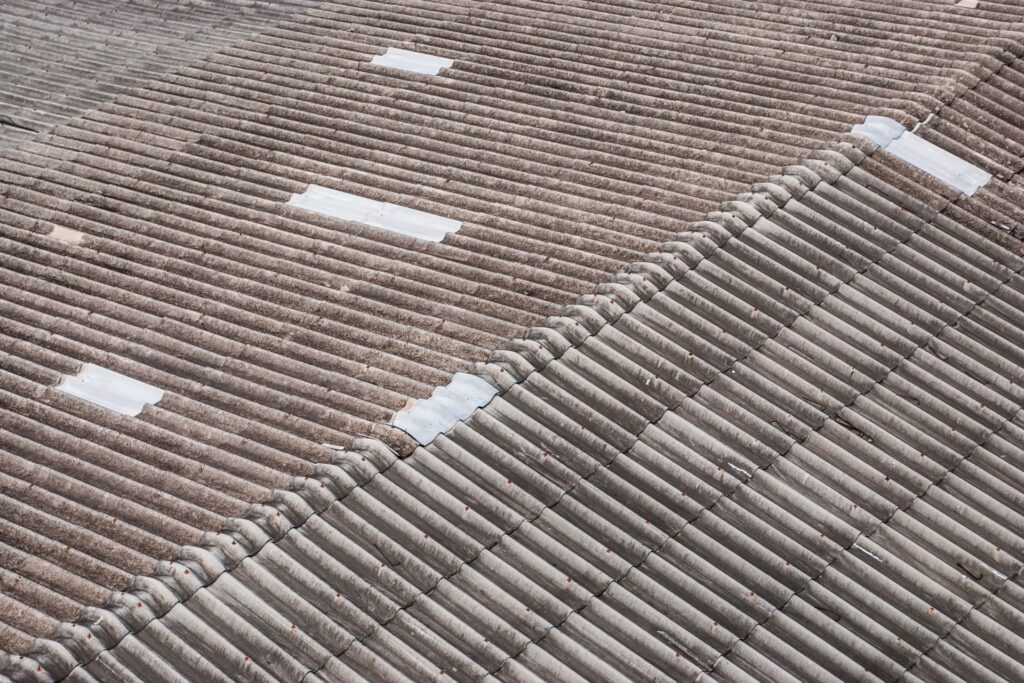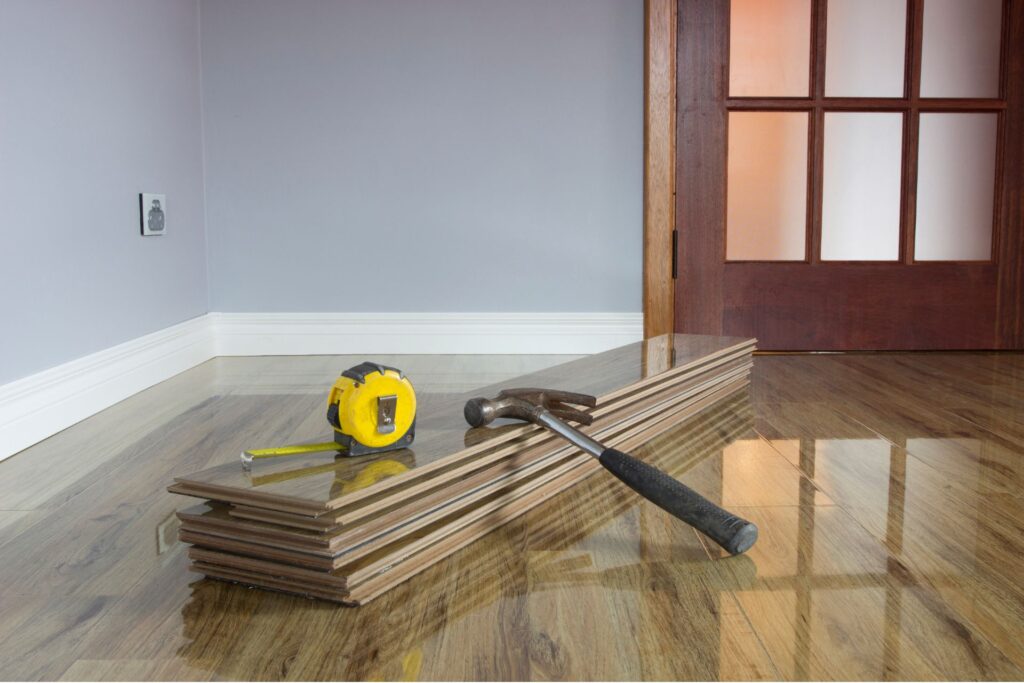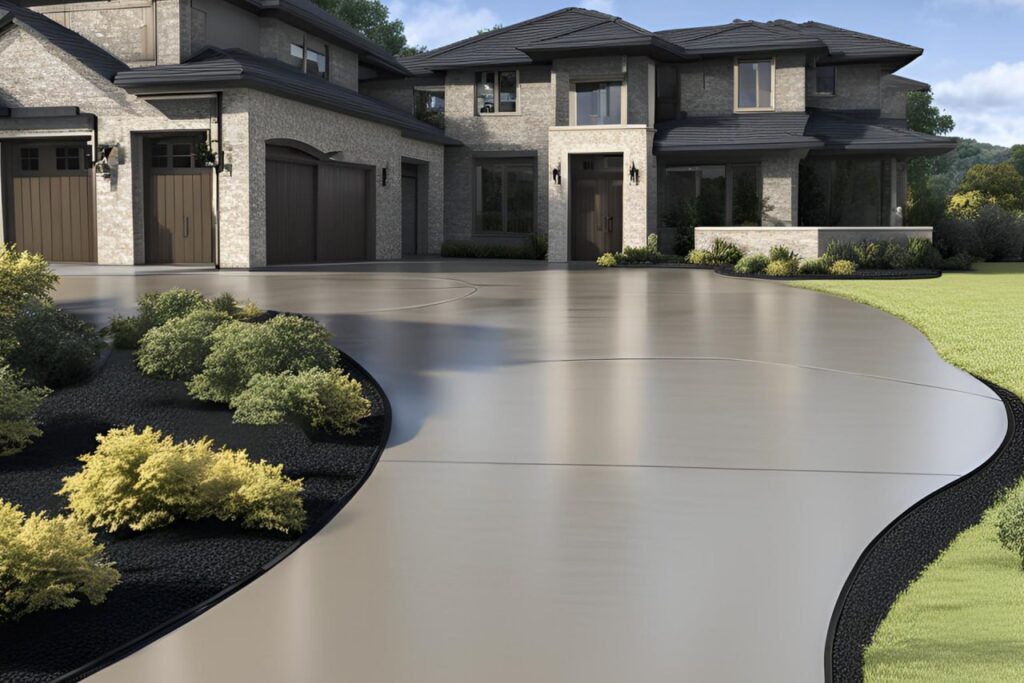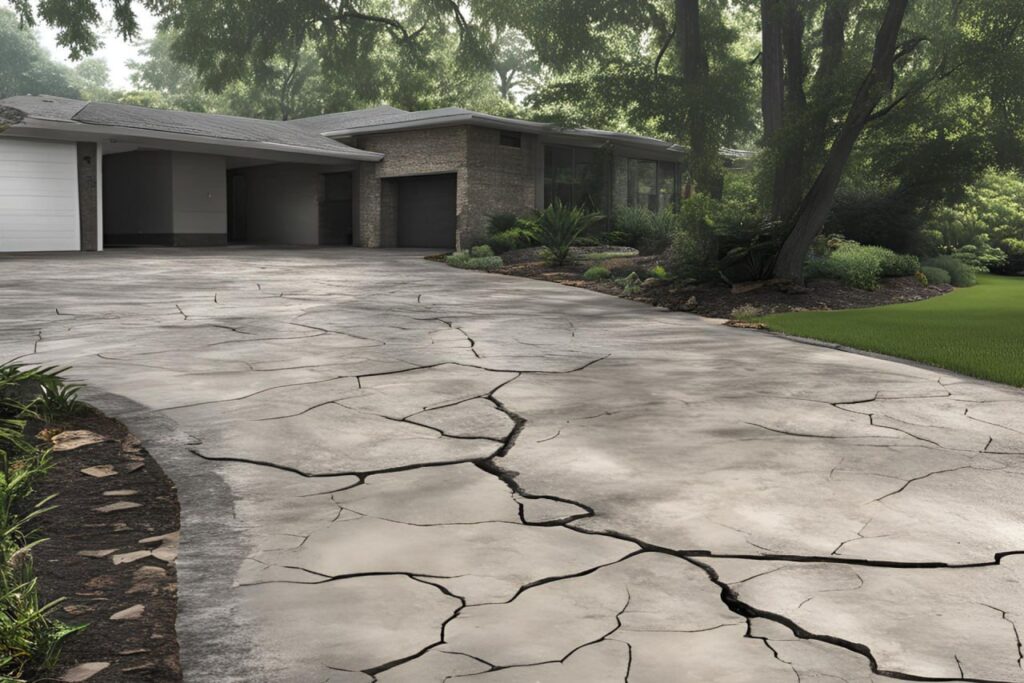Welcome to the ultimate guide to house foundations in New Zealand, where we’ll break down everything you need to know about building a strong and durable base for your home. From understanding the different types of foundations and their suitability for NZ’s unique conditions to exploring costs and key considerations, this guide is designed to answer your questions and provide practical advice. Whether you’re planning a new build, renovating, or simply curious about what keeps your home standing tall, we’ve got you covered with insights tailored to New Zealand’s challenging soils, seismic activity, and climate. Let’s dive in and help you build with confidence!
House foundations in New Zealand typically include concrete slab-on-ground, timber pile foundations, RibRaft foundations, and raised or basement foundations. The choice depends on factors like soil type, seismic activity, and budget. Concrete slabs are popular for stability, while timber piles are ideal for uneven terrain. RibRaft foundations are designed for earthquake resistance, making them a common choice in NZ’s seismic zones. Costs range from $150–$400 per square meter, depending on the type and site conditions.
- Why Are House Foundations Important?
- Common Types Of House Foundations In NZ
- Factors That Influence Foundation Choice In NZ
- House Foundation Costs In NZ: What To Expect
- The Foundation Construction Process In NZ
- Signs Of Foundation Problems And When To Call An Expert
- Tips For Choosing The Right Foundation And Builder In NZ
- FAQs: About The House Foundations NZ
- Conclusion
- Find A Professional Concrete Company Near You!
Why Are House Foundations Important?
House foundations are the cornerstone of every safe and durable home. They serve as the critical base that supports the structure, distributes its weight evenly, and ensures long-term stability. Without a proper foundation, a house is at risk of shifting, cracking, or even collapsing over time. Let’s delve into why foundations are so vital, particularly in the unique conditions found in New Zealand.
The Role Of Foundations In Structural Stability And Durability
At their core, foundations anchor a house securely to the ground. They prevent settling or shifting caused by environmental factors like soil movement, weather changes, and natural disasters. A well-designed foundation ensures that your home remains stable, preventing cracks in walls, uneven floors, or compromised structural integrity. Additionally, foundations act as a barrier against moisture intrusion, safeguarding the interior of your home from potential water damage, mold, and rot. In essence, the foundation is not just the “base” of your home—it is the backbone that keeps everything else in place.
Unique Challenges For House Foundations In NZ
Earthquake Risk: Building For A Seismically Active Country
New Zealand is located along the Pacific Ring of Fire, making it highly prone to earthquakes. This seismic activity poses significant challenges for home foundations. A foundation must be designed to absorb and distribute the energy from earthquakes, minimizing damage to the structure above. For example, RibRaft foundations, which are popular in NZ, are engineered specifically for seismic resilience, offering flexibility and strength during ground movement. Building to meet or exceed the NZ Building Code is crucial, as it incorporates standards that account for earthquake risks, ensuring that foundations provide adequate protection in these conditions.
Soil Variations Across New Zealand
The type and quality of soil can vary significantly across different regions of New Zealand, which directly impacts the foundation type required. For instance.
- Clay Soils: Found in areas like Auckland, clay soils are prone to expansion and contraction with moisture changes, increasing the risk of foundation cracks or shifting.
- Sandy Soils: Common in coastal areas, these soils may require additional compaction or reinforcement to provide a stable base.
- Gravel And Rocky Soils: Found in regions like Canterbury, these can offer excellent stability but may increase excavation costs.
The foundation design must account for these variations, as building on unstable or unsuitable soil without proper preparation can lead to costly repairs down the road.
A Relatable Example: The Sturdy Boots Of Your Home
Think of a foundation as the sturdy boots your house wears to handle New Zealand’s unpredictable terrain. Just as a good pair of boots provides support, balance, and protection against uneven surfaces, a strong foundation ensures that your home can withstand the challenges of shifting soils, heavy rainfall, and even earthquakes. Without the right “boots,” your house is more vulnerable to damage and instability over time.
In New Zealand, where unique environmental challenges like seismic activity and diverse soil types are part of the landscape, investing in a properly designed foundation is essential. It not only ensures the safety and longevity of your home but also protects your investment for years to come. Whether you’re planning a new build or evaluating an existing structure, understanding the importance of foundations is the first step toward a stable and secure home.

Common Types Of House Foundations In NZ
When it comes to building a home in New Zealand, choosing the right foundation is crucial to ensuring long-term stability and durability. The foundation type you select depends on factors such as soil conditions, terrain, climate, and budget. Below, we’ll explore the most common types of house foundations in NZ, breaking down how they work, their advantages and disadvantages, and the ideal scenarios for each.
Concrete Slab-On-Ground
How It Works
A concrete slab-on-ground foundation involves pouring a thick layer of reinforced concrete directly onto a prepared and leveled surface. This type of foundation creates a flat, solid base for the home. A damp-proof membrane is usually laid underneath to prevent moisture from rising into the structure.
Pros
- Affordability: Typically less expensive than other foundation types due to its straightforward construction process.
- Durability: Provides a strong and stable base that resists settling.
- Moisture Resistance: Effective at keeping moisture out when properly sealed.
Cons
- Limited Flexibility: Not ideal for sloping or uneven terrain.
- Crack Risk: Vulnerable to cracking over time, particularly in regions with highly reactive clay soils.
Ideal Scenarios
Concrete slab foundations are most suitable for flat, stable terrain and areas with well-draining soil. They are a popular choice in urban areas like Auckland and Wellington, where space is limited, and land is generally level.
Timber Pile Foundations
How It Works
Timber pile foundations involve driving wooden piles into the ground to support the home’s structure. These piles elevate the house above ground level, creating a crawl space beneath.
Pros
- Adaptability: Ideal for sloping or uneven sites, as the height of the piles can be adjusted.
- Cost-Effective: More affordable than some modern foundation systems, especially for small or lightweight homes.
- Good Ventilation: The raised design allows for air circulation underneath the home, reducing moisture buildup.
Cons
- Durability Issues: Susceptible to rot, pests, and weathering without proper treatment.
- Limited Stability: Not suitable for areas with high seismic activity or unstable soils.
Ideal Scenarios
Timber piles are commonly used in coastal or rural areas, especially for homes built on hillsides or flood-prone land. They’re an excellent option for lighter, smaller structures or traditional-style homes.
RibRaft Foundations
How It Works
RibRaft foundations are an innovative system that combines concrete with polystyrene pods and steel reinforcements. The polystyrene pods create a grid-like structure, reducing the amount of concrete needed while improving the foundation’s flexibility.
Pros
- Seismic Resilience: Specifically designed to perform well in earthquake-prone regions.
- Energy Efficiency: The polystyrene pods provide insulation, helping to keep homes warmer.
- Lightweight Design: Reduces the overall weight of the structure, minimizing ground settlement.
Cons
- Higher Initial Cost: More expensive than traditional concrete slabs due to the specialized materials and installation process.
- Complex Construction: Requires skilled professionals for proper installation.
Ideal Scenarios
RibRaft foundations are a top choice in earthquake-prone areas like Christchurch and Wellington. They’re also well-suited for homes in regions with expansive clay soils, where flexibility and durability are essential.
Basement Or Raised Foundations
How It Works
Basement or raised foundations involve constructing a deeper foundation to create additional living or storage space beneath the main structure. This type of foundation is often built using reinforced concrete or block walls.
Pros
- Additional Space: Provides extra room for storage, living areas, or utilities.
- Stability: Offers excellent load-bearing capacity and durability.
- Flood Protection: Raises the home above potential flood levels.
Cons
- High Cost: Typically the most expensive foundation type due to the excavation and materials required.
- Time-Consuming: Takes longer to construct compared to other foundation types.
Ideal Scenarios
Basement or raised foundations are ideal for sloping sites, where the natural gradient can be utilized to create a lower level. They’re also a practical option for areas prone to flooding, such as parts of the Waikato and Bay of Plenty.
Selecting the right foundation is one of the most important decisions you’ll make when building your home in New Zealand. Each foundation type has unique advantages and challenges, so it’s essential to consider your site conditions, budget, and long-term needs. Whether it’s the cost-effectiveness of a concrete slab, the adaptability of timber piles, the seismic resilience of RibRaft systems, or the space efficiency of a basement foundation, there’s a solution for every situation.
By understanding the options available and working with qualified professionals, you can ensure your foundation is strong, stable, and built to withstand New Zealand’s unique conditions.
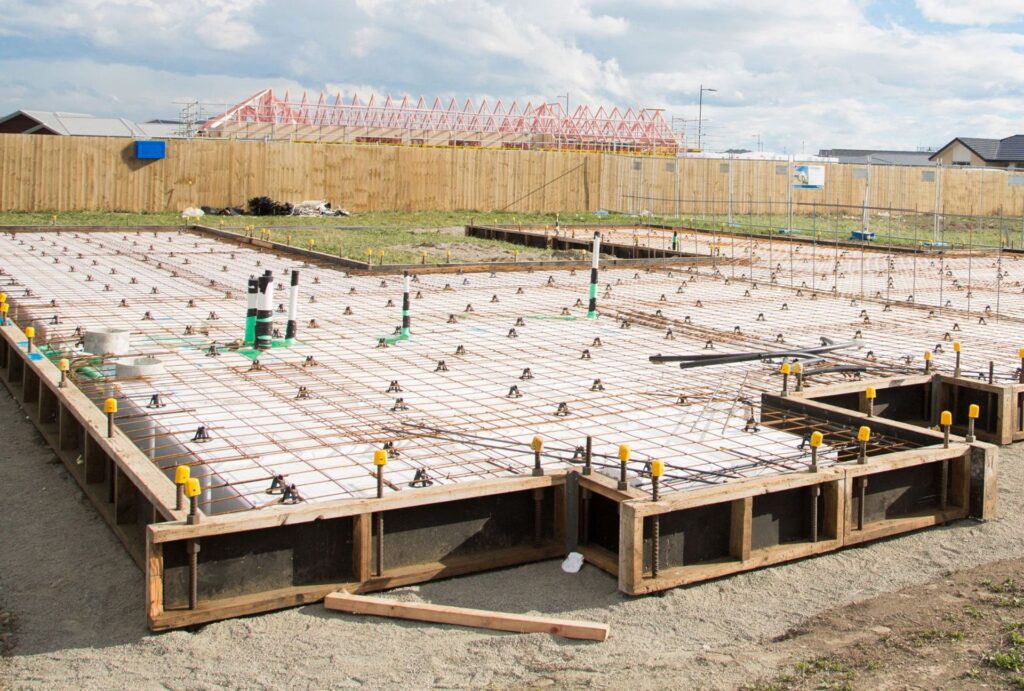
Factors That Influence Foundation Choice In NZ
When building a home in New Zealand, the foundation is not just a structural necessity—it’s a critical decision influenced by various environmental, geological, and financial factors. From soil conditions to climate and budget, each element plays a significant role in determining the type of foundation that will ensure long-term stability and safety. Below, we explore the key factors that influence foundation choices across New Zealand.
Soil Type And Site Conditions
New Zealand’s diverse landscapes bring with them a wide range of soil types, each with unique challenges for foundation design. Understanding the local soil conditions is essential to choosing a foundation that provides the right level of support and stability.
Regional Soil Differences
- Clay Soils (Auckland): Clay soils are common in areas like Auckland and are known for their tendency to expand and contract with changes in moisture levels. This movement can put pressure on foundations, leading to cracks or instability. RibRaft or specially engineered concrete slab foundations are often recommended for such conditions to minimize damage.
- Gravel Soils (Canterbury): Gravelly soils found in regions like Canterbury offer excellent drainage and stability, making them ideal for standard concrete slab foundations. However, seismic considerations in this area may still require additional reinforcement.
- Sandy Soils (Coastal Areas): Coastal regions often have sandy soils, which may lack the compactness needed for stable foundations. Additional site preparation, like soil compaction or pile-driven foundations, is often necessary.
- Volcanic Soils (Central Plateau): Volcanic soils can vary significantly in density and composition, requiring thorough site testing to determine the best foundation solution.
Importance Of Site Investigations
Site investigations, including soil testing, are crucial before construction begins. These tests help identify soil properties such as bearing capacity, drainage, and reactivity, ensuring the chosen foundation type is tailored to the site’s specific needs.
Seismic Considerations
New Zealand’s location along the Pacific Ring of Fire means that seismic activity is a significant factor in foundation design. Earthquakes can cause ground shaking, soil liquefaction, and uneven settling, all of which can compromise a home’s structural integrity if the foundation isn’t properly designed.
The Need For Earthquake-Resistant Foundations
Foundations must be engineered to handle the stresses caused by seismic activity. RibRaft foundations and other reinforced concrete systems are popular choices because they distribute seismic forces evenly, reducing the risk of damage. Timber piles with bracing can also be used in some scenarios to provide flexibility during ground movement.
Compliance With NZ Building Code
The NZ Building Code outlines specific requirements for earthquake-resistant designs, ensuring that new homes are built to withstand seismic events. Choosing a foundation type that complies with these standards is not only legally required but also vital for safety and peace of mind.
Local Climate
New Zealand’s varied climate, from the wet and windy west coast to the drier regions of Central Otago, has a direct impact on foundation performance. Moisture levels, drainage, and temperature fluctuations must all be considered when selecting a foundation.
Moisture Levels And Drainage
- In areas with high rainfall, such as the West Coast, poor drainage can lead to water pooling around foundations, increasing the risk of erosion, mold, and structural damage. Raised timber pile foundations or foundations with integrated drainage systems are often used in these regions to combat moisture issues.
- In drier areas, like Canterbury, the risk of soil shrinkage during prolonged dry spells can affect the stability of clay-based soils. Foundations designed to handle soil movement, such as RibRaft systems, can mitigate this risk.
Insulation And Energy Efficiency
In colder climates, such as the southern regions, insulated foundations like RibRaft systems help maintain indoor warmth and energy efficiency. This can reduce long-term heating costs while providing a stable base for the home.
Budget And Project Scope
The cost of a foundation is influenced by the type of foundation required, site conditions, and additional features like drainage or earthquake-resistant designs. Balancing your budget with the structural needs of your home is a crucial step in the decision-making process.
Foundation Type And Costs
- Concrete Slab-On-Ground: Typically costs $150–$300 per square meter and is a budget-friendly option for flat sites with stable soil.
- Timber Pile Foundations: These are often more affordable for sloping or uneven sites, costing around $10,000–$25,000 for a standard home.
- RibRaft Foundations: These can cost $300–$400 per square meter due to their advanced seismic and insulation features but are worth the investment in earthquake-prone areas.
Hidden Costs To Consider
Additional expenses such as soil testing, excavation, drainage systems, and council consents can significantly impact the overall budget. It’s essential to plan for these costs early to avoid surprises.
Matching Project Scope
For larger or more complex projects, such as homes with multiple stories or sloping sites, the foundation type may require advanced engineering and higher costs. However, investing in a suitable foundation ensures long-term savings by reducing the risk of repairs or structural issues in the future.
Choosing the right foundation for your home in New Zealand requires careful consideration of soil conditions, seismic risks, climate, and budget. Each factor plays a critical role in ensuring the safety, durability, and cost-effectiveness of your home’s base. By working with experienced professionals and conducting thorough site investigations, you can confidently select a foundation that meets the unique demands of your location while staying within your budget. A well-chosen foundation is not just a necessity—it’s a smart investment in your home’s future stability and value.
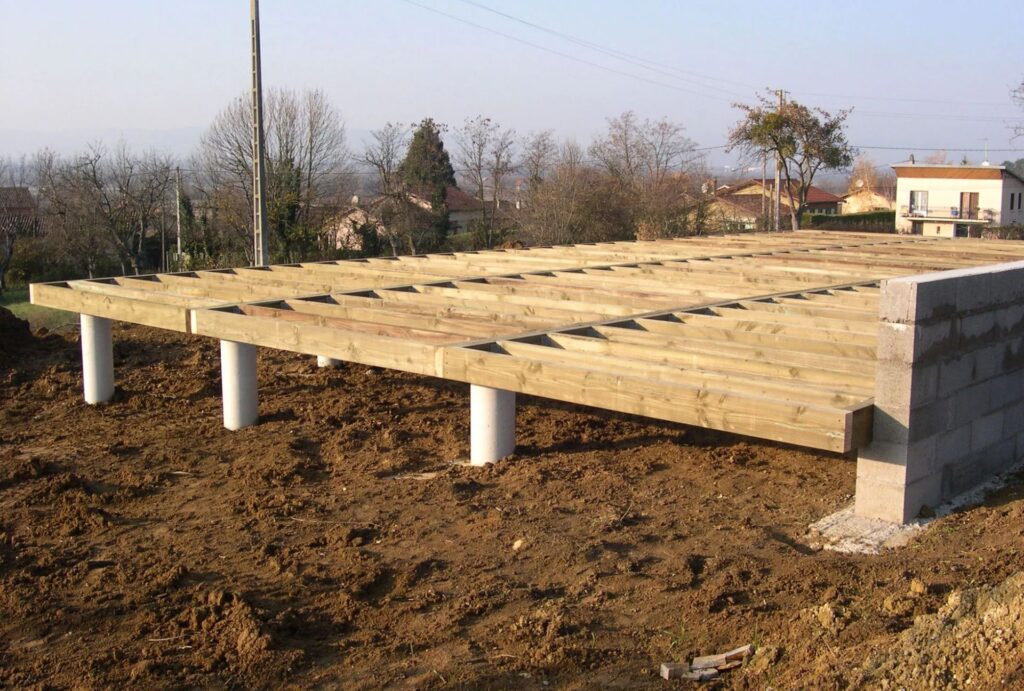
House Foundation Costs In NZ: What To Expect
Building a strong foundation for your home is one of the most significant investments in the construction process. While the costs can vary widely depending on location, site conditions, and the type of foundation, understanding the factors influencing these costs can help you plan your budget more effectively. Let’s break down the key elements that affect foundation expenses in New Zealand and provide cost estimates to guide your planning.
Factors Influencing Cost
Several factors determine the overall cost of a house foundation in New Zealand. Each of these elements plays a critical role in ensuring your foundation is safe, durable, and compliant with local building standards.
Type Of Foundation
The type of foundation you choose has the most significant impact on cost. Different foundation systems are suited to specific terrains, soil types, and design preferences.
- Concrete Slab-On-Ground: A common choice for flat sites, offering affordability and durability.
- Timber Pile Foundations: Ideal for sloping or uneven terrain, with the added advantage of good ventilation.
- RibRaft Foundations: Designed for seismic resilience, these foundations are often chosen in earthquake-prone areas.
Each type has unique material, labor, and installation requirements, which directly influence the overall cost.
Site Preparation
Preparing the site for the foundation is often a time-consuming and expensive part of the process. Key site preparation tasks include.
- Soil Testing: Essential for determining the soil’s load-bearing capacity and stability.
- Leveling And Excavation: Uneven or sloping land requires additional leveling, which can increase costs.
- Clearing And Drainage: Removing vegetation, rocks, or existing structures and ensuring proper drainage can add to the expense.
Sites with challenging soil conditions, such as clay or sandy soils, may require additional preparation, which can raise the overall cost.
Engineering And Compliance Costs
Building a foundation in New Zealand requires adherence to strict regulations, especially in areas prone to earthquakes or flooding. These costs include.
- Engineering Reports: Detailed assessments to ensure the foundation meets seismic and structural requirements.
- Building Consents: Obtaining council approvals and inspections to ensure compliance with the NZ Building Code.
While these costs may seem high, they are essential for ensuring your foundation is safe and long-lasting.
Average Cost Estimates
Here’s an overview of typical foundation costs in New Zealand. These figures are averages and can vary based on factors such as site conditions, foundation type, and location.
- Concrete Slab-On-Ground: $150–$300 per m².
- Affordable and suitable for flat, stable sites.
- Costs increase if additional reinforcement or waterproofing is required.
- Timber Pile Foundations: $10,000–$25,000 for smaller homes.
- Best for uneven terrain or flood-prone areas.
- Requires treatment to resist pests and moisture, which may increase costs.
- RibRaft Foundations: $300–$400 per m².
- Offers seismic resilience and insulation.
- Higher material costs but ideal for earthquake-prone regions.
These figures provide a starting point, but it’s crucial to get detailed quotes from professionals based on your specific project.
Additional Costs To Consider
Beyond the primary foundation costs, there are several additional expenses that homeowners should factor into their budget.
Council Consents
Local councils require building consents to ensure that the foundation design complies with New Zealand’s regulations. Consent fees can range from a few hundred to several thousand dollars, depending on the complexity of the project.
Drainage And Waterproofing Systems
Proper drainage and waterproofing are essential to prevent water damage and moisture buildup around the foundation. Installing these systems can add to the overall cost but is a necessary investment for long-term durability.
Unexpected Site Challenges
Unforeseen issues such as poor soil conditions, buried debris, or rock layers can significantly increase excavation and preparation costs. Budgeting for contingencies is essential to avoid surprises during construction.
Tips For Budgeting And Avoiding Hidden Costs
- Get Multiple Quotes: Request detailed quotes from several builders or contractors to compare costs and services. Ensure all estimates include site preparation, materials, and compliance fees.
- Conduct A Thorough Site Investigation: Invest in soil testing and geotechnical reports early to identify potential challenges and avoid costly surprises later.
- Plan For Contingencies: Set aside at least 10–15% of your foundation budget for unexpected expenses like poor soil conditions or additional engineering requirements.
- Choose The Right Foundation: Work with professionals to select a foundation type that balances your budget with the specific needs of your site. For example, while RibRaft foundations may have higher upfront costs, they could save you money in earthquake-prone regions by minimizing repair needs later.
- Consult Local Experts: Builders with experience in your area are more likely to understand the specific challenges of your region’s soil and climate, ensuring an efficient and cost-effective foundation process.
The cost of a house foundation in New Zealand varies depending on several factors, from the type of foundation to the site’s unique characteristics. By understanding these costs and planning carefully, you can make informed decisions that ensure your foundation is both durable and budget-friendly. Whether you’re working with a flat site that’s ideal for a concrete slab or tackling challenging terrain with timber piles, investing in the right foundation is the first step toward a safe and secure home. Proper preparation, compliance with regulations, and careful budgeting will set you on the path to building a home that stands the test of time.

The Foundation Construction Process In NZ
Building a solid foundation is one of the most critical stages in constructing a home. In New Zealand, the process involves several well-defined steps to ensure the foundation is stable, durable, and compliant with local regulations. From initial site investigations to final inspections, each phase plays a vital role in creating a base that supports your home for decades to come. Below is a detailed step-by-step explanation of the foundation construction process in NZ, along with estimated timelines and answers to common questions.
Step 1: Site Investigation And Soil Testing
Before construction begins, a thorough investigation of the site is conducted. This step involves.
- Soil Testing: Engineers analyze the soil to determine its load-bearing capacity, stability, and drainage properties. These tests are crucial for identifying potential challenges, such as reactive clay soils, sandy terrains, or seismic risks.
- Geotechnical Reports: A detailed report is prepared to guide the foundation design based on the site’s unique characteristics.
Estimated Timeline
This step typically takes 1–2 weeks, depending on the availability of engineers and the complexity of the site conditions.
Step 2: Choosing The Foundation Type
Based on the results of the site investigation, the most suitable foundation type is selected. Common options in New Zealand include.
- Concrete Slab-On-Ground: Ideal for flat, stable sites with well-draining soils.
- Timber Pile Foundations: Suited for sloping or uneven terrains and areas prone to flooding.
- RibRaft Foundations: A preferred choice in earthquake-prone regions due to their seismic resilience.
During this stage, structural engineers and builders collaborate to finalize the design and ensure it meets NZ Building Code requirements.
Estimated Timeline
This decision-making process usually takes 1–2 weeks, as it involves consultations and approvals.
Step 3: Preparation And Excavation
Once the foundation type is decided, the site is prepared for construction. This involves.
- Clearing The Site: Removing vegetation, debris, or any existing structures.
- Leveling: Flattening the ground to create a stable surface for the foundation.
- Excavation: Digging trenches or holes for footings, piles, or basement foundations.
- Installing Drainage Systems: Ensuring proper drainage to prevent water buildup around the foundation.
In areas with challenging terrain, such as steep slopes or rocky soils, this step may require additional time and specialized equipment.
Estimated Timeline
Preparation and excavation typically take 1–3 weeks, depending on the complexity of the site.
Step 4: Laying The Foundation
This step involves constructing the actual foundation, which varies depending on the type chosen.
- Pouring Concrete Slabs: For slab-on-ground or RibRaft foundations, concrete is poured into molds or grids, often reinforced with steel for added strength.
- Installing Timber Piles: For pile foundations, treated timber posts are driven into the ground to provide a sturdy base.
- Building Basement Walls: For homes with basements or raised foundations, reinforced concrete or masonry walls are constructed.
During this stage, additional measures such as waterproofing and insulation may also be implemented to enhance the foundation’s performance.
Estimated Timeline
The foundation construction phase typically takes 1–2 weeks for simpler designs, but it can take up to 4 weeks for complex systems like basements or large RibRaft foundations.
Step 5: Final Inspections And Compliance Checks
Before proceeding with the rest of the construction, the foundation must undergo a series of inspections to ensure it meets New Zealand’s strict building standards. Key tasks include.
- Council Inspections: Local authorities check that the foundation complies with the NZ Building Code.
- Structural Assessments: Engineers verify that the foundation can support the intended load and handle environmental stresses.
Once all inspections are passed, the project receives official approval, allowing construction to continue.
Estimated Timeline
This step usually takes 1–2 weeks, depending on council scheduling and the complexity of the foundation design.
The foundation construction process in New Zealand involves several detailed steps, each tailored to the site’s unique conditions and the project’s specific needs. By understanding these stages—site investigation, design selection, preparation, construction, and inspection—you can confidently navigate the process and ensure your home is built on a stable and secure base. Working with experienced professionals and adhering to local regulations will not only save time and money but also provide peace of mind that your home is ready to withstand New Zealand’s diverse environmental challenges.

Signs Of Foundation Problems And When To Call An Expert
Your home’s foundation is essential for its stability, and even minor issues can become significant if left unaddressed. Recognizing the early warning signs of foundation problems is critical to protecting your home from further damage and costly repairs. Below, we’ll outline the most common signs of foundation trouble, the causes of these issues in New Zealand, and when it’s time to call an expert.
Common Warning Signs
Foundation problems often reveal themselves through noticeable changes in your home’s structure. Here are the most common warning signs to watch for.
Cracks In Walls Or Floors
One of the earliest and most visible signs of foundation trouble is cracks forming in your walls or floors. Pay attention to.
- Horizontal Cracks: These may indicate excessive pressure on the foundation walls.
- Vertical Or Diagonal Cracks: Often caused by uneven settling or shifting of the foundation.
- Floor Cracks: These can suggest movement in the foundation slab, particularly in homes with concrete foundations.
Uneven Or Sinking Floors
If your floors feel uneven when you walk or you notice visible sloping, this could indicate foundation settling or shifting. Over time, uneven floors can worsen, leading to structural instability and further damage.
Doors And Windows Sticking
Difficulty opening or closing doors and windows may signal foundation movement. Shifting foundations can cause the frames to become misaligned, making them stick or fail to latch properly.
If you notice any of these signs, it’s essential to act promptly, as foundation problems can escalate over time, leading to more extensive damage to your home.
Causes Of Foundation Issues In NZ
Foundation problems are often the result of environmental factors and site-specific challenges. In New Zealand, the following causes are particularly common.
Poor Drainage
Inadequate drainage around your home can lead to water pooling near the foundation. Over time, excess moisture can weaken the soil, causing the foundation to sink or shift. Homes in areas with heavy rainfall, such as the West Coast, are particularly vulnerable to drainage-related issues.
Shifting Soil
New Zealand’s diverse soil types can pose challenges for foundations. Clay soils, common in Auckland, expand and contract with moisture changes, putting pressure on the foundation. Sandy soils, often found in coastal areas, may lack the stability needed to support a home, leading to settlement or sinking.
Earthquakes
Located on the Pacific Ring of Fire, New Zealand is highly prone to earthquakes. The ground movement during seismic activity can cause foundations to crack, shift, or settle unevenly. Homes in regions like Christchurch or Wellington are particularly at risk, requiring foundations designed to handle seismic forces.
Understanding these causes can help you take proactive steps to protect your foundation and prevent potential issues.
What To Do
If you suspect foundation problems in your home, it’s essential to act quickly to prevent further damage. Here’s what you should do.
Contact A Licensed Professional
Foundation issues require expert evaluation. A licensed structural engineer or foundation specialist can assess the extent of the problem and recommend appropriate solutions. For example.
- Minor Cracks: These may require simple sealing or reinforcement.
- Severe Shifting: This may necessitate foundation underpinning or replacement.
In New Zealand, ensure the professional you hire is experienced with local soil conditions and compliant with NZ Building Code standards.
Don’t Panic—Most Problems Can Be Fixed
Foundation problems can seem overwhelming, but the good news is that most issues are repairable. Whether it’s stabilizing the foundation, addressing drainage problems, or reinforcing earthquake resilience, there are proven solutions for every scenario.
Prevent Future Issues
Once repairs are completed, take steps to prevent future problems.
- Install proper drainage systems to divert water away from the foundation.
- Regularly inspect your home for early warning signs of trouble.
- Work with professionals to ensure your foundation meets the demands of your region’s soil and climate.
When To Call An Expert
While minor cracks or sticking doors might seem manageable, certain situations call for immediate professional attention.
- Large Or Widening Cracks: Cracks wider than 5mm or growing over time should be evaluated immediately.
- Sudden Shifts: Noticeable changes in floors or walls over a short period may indicate significant foundation movement.
- Earthquake Damage: After a seismic event, have your foundation inspected, even if no visible damage is present.
By addressing foundation issues early, you can avoid more extensive and expensive repairs down the road.
Your home’s foundation is its most critical structural component, and recognizing the signs of trouble is the first step in protecting your investment. Whether it’s cracks, uneven floors, or sticking doors, these warning signs can indicate underlying foundation problems that need expert attention. In New Zealand, where soil challenges and seismic activity are common, working with licensed professionals ensures your foundation is repaired and reinforced to withstand the unique demands of the region. Don’t wait—take action today to safeguard your home’s stability and value for the years to come.

Tips For Choosing The Right Foundation And Builder In NZ
Building a home is a significant investment, and choosing the right foundation and builder plays a crucial role in ensuring its safety and durability. In New Zealand, unique challenges like diverse soil types, seismic activity, and varying climate conditions make this decision even more critical. Here’s a detailed guide to help you select the ideal foundation and a reliable builder for your project.
Key Questions To Ask Builders
When selecting a builder for your foundation, asking the right questions can help you gauge their expertise and suitability for your project. Here are the essential questions to ask.
1. Do You Have Experience With Local Soil And Seismic Conditions?
New Zealand’s varied landscapes require builders who understand the challenges of local soil types and seismic risks. For example.
- In Auckland, builders must be familiar with reactive clay soils that expand and contract.
- In Christchurch, expertise in designing earthquake-resistant foundations like RibRaft systems is crucial.
Choosing a builder with local experience ensures they can recommend the most appropriate foundation type for your site.
2. Can You Provide Examples Of Past Projects?
Requesting examples of completed projects can give you confidence in the builder’s ability to handle similar jobs. Look for projects with comparable soil conditions, foundation types, or design complexities. This will help you assess their quality of work and attention to detail.
3. What Warranty And Aftercare Services Do You Offer?
A reputable builder should provide warranties on their work, covering defects or issues that may arise after construction. Additionally, ask about their aftercare services, such as inspections, maintenance tips, or support for future repairs. These services indicate a builder’s commitment to long-term client satisfaction.
How To Find A Reliable Builder
Finding a trustworthy builder in New Zealand requires research and due diligence. Here are some practical steps to ensure you hire the right professional.
Check Reviews And References
Look for online reviews and testimonials from previous clients. Platforms like Trade Me, Houzz, or local builder directories can provide insights into a builder’s reputation. Additionally, ask the builder for references and follow up with past clients to learn about their experiences.
Verify NZ Building Code Compliance
Ensure the builder is licensed and compliant with the NZ Building Code. This is particularly important for foundations, as they must meet strict standards for seismic resilience, drainage, and structural stability. You can verify their credentials through professional organizations like the Licensed Building Practitioners (LBP) register or the Registered Master Builders Association.
Futureproofing Your Foundation
Investing in a well-designed foundation is only the first step. Proper planning and maintenance are essential to ensure your foundation remains strong and durable for years to come.
Importance Of Drainage Systems
Drainage is a critical factor in protecting your foundation from water damage. In areas with heavy rainfall, such as the West Coast, proper drainage systems help prevent water pooling around the foundation, which can weaken the soil and lead to shifting or settlement. Work with your builder to install effective drainage solutions, such as.
- Perimeter drains to channel water away from the home.
- Sump pumps for areas prone to flooding.
- Sloping the ground away from the foundation to promote runoff.
Regular Maintenance Tips
Maintaining your foundation is key to avoiding costly repairs in the future. Here are some tips to keep it in top condition.
- Inspect Regularly: Check for cracks, moisture buildup, or signs of settling around your foundation.
- Control Vegetation: Keep trees and shrubs at least a few meters away from the foundation to prevent roots from causing damage.
- Manage Water Drainage: Regularly clean gutters and downspouts to ensure water is directed away from your home.
- Repair Issues Promptly: Address minor cracks or drainage problems early to prevent them from escalating into major concerns.
By taking these steps, you can extend the lifespan of your foundation and protect your home from potential structural issues.
Choosing the right foundation and builder in New Zealand requires careful consideration and planning. By asking key questions, researching potential builders, and prioritizing futureproofing measures like drainage systems and maintenance, you can ensure your home is built on a solid, reliable base. Remember, a strong foundation isn’t just about the present—it’s an investment in the safety, durability, and value of your home for generations to come. Take your time to find a builder who understands the unique challenges of your location and works with you to create a foundation that will stand the test of time.
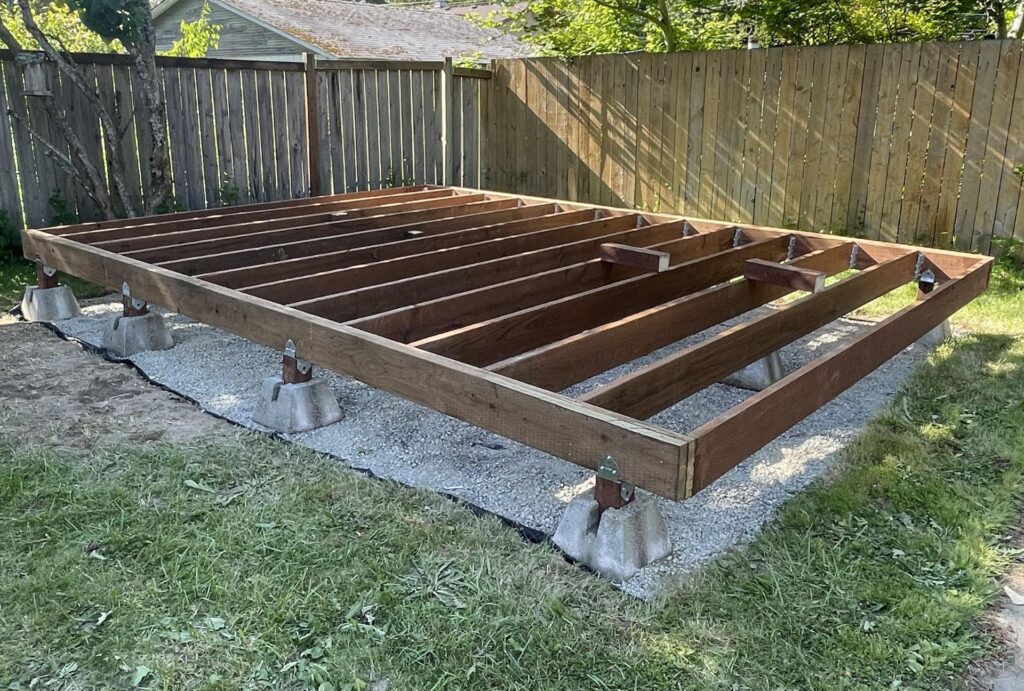
FAQs: About The House Foundations NZ
Conclusion
Choosing the right foundation is one of the most critical decisions when building a home in New Zealand, as it directly impacts the safety, durability, and longevity of your structure. With the country’s diverse soil types, seismic risks, and varying climate conditions, selecting a foundation tailored to your site’s specific needs is essential. A well-planned foundation ensures stability and protects your investment, making it vital to seek professional advice from licensed experts who understand local challenges. By conducting thorough site investigations, prioritizing compliance with the NZ Building Code, and planning carefully, you can lay the groundwork for a home that stands the test of time. Ready to start your building journey? Consult with an expert today to ensure your house stands strong for generations.
Find A Professional Concrete Company Near You!
- Asphalt Carpark Construction Wairarapa
- Asphalt Contractors Auckland
- Asphalt Contractors Hawkes Bay
- Asphalt Dannevirke
- Asphalt Driveways Tauranga
- Christchurch Concrete Services
- Concrete Contractors Nelson
- Concrete Contractors Tauranga
- Concrete Dannevirke
- Concrete Driveways Lower Hutt
- Concrete Driveways Upper Hutt
- Concrete Floor Slabs Kapiti Coast
- Concrete Foundations Kapiti
- Concrete Layers Auckland
- Concrete Layers Cambridge
- Concrete Layers Hamilton
- Concrete Layers Invercargill
- Concrete Layers Kapiti
- Concrete Layers Leigh
- Concrete Layers Levin
- Concrete Layers Lower Hutt
- Concrete Layers Mangawhai
- Concrete Layers Matakana
- Concrete Layers North Shore
- Concrete Layers Northland
- Concrete Layers Orewa
- Concrete Layers Palmerston North
- Concrete Layers Pukekohe
- Concrete Layers Rodney
- Concrete Layers Silverdale
- Concrete Layers Te Awamutu
- Concrete Layers Upper Hutt
- Concrete Layers Waikato
- Concrete Layers Warkworth
- Concrete Layers Wellington
- Concrete Layers Wellsford
- Concrete Manuwatu
- Concrete Services Rotorua
- Concrete Whangarei
- Hastings Concrete Company
- Hawkes Bay Concrete Company
- Napier Concrete Company
About the Author:
Mike Veail is a recognized digital marketing expert with over 6 years of experience in helping tradespeople and small businesses thrive online. A former quantity surveyor, Mike combines deep industry knowledge with hands-on expertise in SEO and Google Ads. His marketing strategies are tailored to the specific needs of the trades sector, helping businesses increase visibility and generate more leads through proven, ethical methods.
Mike has successfully partnered with numerous companies, establishing a track record of delivering measurable results. His work has been featured across various platforms that showcase his expertise in lead generation and online marketing for the trades sector.
Learn more about Mike's experience and services at https://theleadguy.online or follow him on social media:

